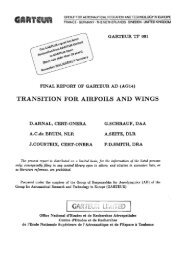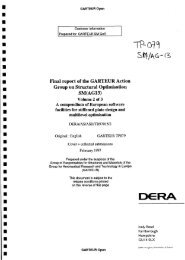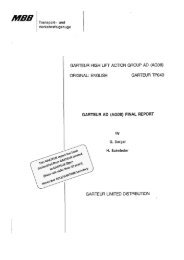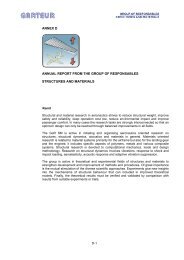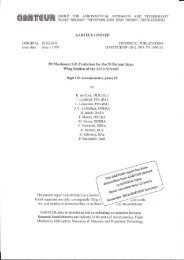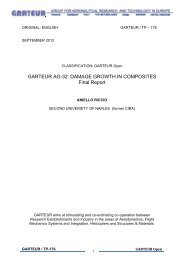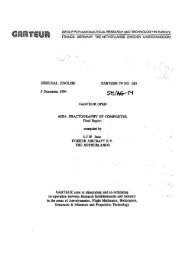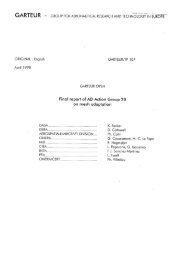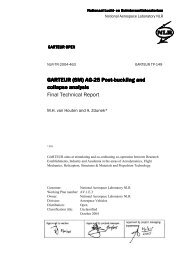Cadmium Substitution - garteur
Cadmium Substitution - garteur
Cadmium Substitution - garteur
You also want an ePaper? Increase the reach of your titles
YUMPU automatically turns print PDFs into web optimized ePapers that Google loves.
GARTEUR LIMITED<br />
The barrier properties of the coatings were determined from electrochemical<br />
measurements. These established that the zinc alloy coatings and zinc based metallicceramic<br />
coatings were similar in performance to electroplated cadmium. The aluminium<br />
based coatings all gave much lower corrosion currents implying that they were more<br />
effective barrier coatings. The sacrificial properties of the coatings were assessed from<br />
open circuit potential experiments and from the use of scratch model specimens and<br />
protection distance measurements. The main conclusions were that pure aluminium<br />
coatings and an aluminium based metallic-ceramic coating were less effective than<br />
cadmium plating. Overall the zinc alloy coatings were more effective than the aluminium<br />
coatings.<br />
Two methods were employed to study the galvanic compatibility between coatings and<br />
aerospace aluminium alloys. In the first coated bolts inserted into aluminium alloy blocks<br />
were exposed to neutral salt fog and at an outdoor exposure site. The results obtained<br />
indicated that the zinc based metallic-ceramic coatings were the most promising as no<br />
rusting was detected. The second approach used was to measure the galvanic current<br />
developed between coated panels and aluminium alloy. The results obtained indicate<br />
that ED aluminium and ED zinc-nickel coatings lower the corrosion rate of the aluminium<br />
alloy. Other coatings studied were found to accelerate the rate of corrosion above that<br />
found for cadmium plating.<br />
The effects of coating on fatigue performance were assessed using notched specimens<br />
tested under constant amplitude tests. It was established that for the ED aluminium, the<br />
two metallic-ceramic coatings and UBMS aluminium - magnesium coatings the reduction<br />
in fatigue strength was less than 5%. ED zinc-cobalt-iron and cadmium gave similar<br />
reductions of ~10% whilst the ED zinc-nickel coatings had the most detrimental effect<br />
being ~25%.<br />
Sustained load tests conducted on coated notch specimens, exposed to sodium chloride<br />
solution, indicated that the zinc based metallic-ceramic and ED zinc-cobalt -iron coatings<br />
may promote stress corrosion cracking in high strength steels. Additional tests carried<br />
out including the slow bend test suggest that any susceptibility to hydrogen<br />
embrittlement may be minimised by heat treatment after electroplating.<br />
Most of the replacement coatings examined failed to show any significant degradation on<br />
exposure to a range of chemicals used on aircraft. Exceptions were ED zinc-nickel<br />
coatings in contact with Turco 5948 and ED zinc-cobalt coatings immersed in Skydrol<br />
hydraulic fluid. <strong>Cadmium</strong> plating was also found to be degraded by these fluids.<br />
Cross-cut tests show that good paint adhesion may be achieved with metal coatings. An<br />
important factor is the time delay between passivation and the application of a primer.<br />
Data obtained indicate that if the passivated surfaces are exposed to the atmosphere for<br />
too long, poor paint adhesion may be obtained.<br />
Tribological studies were conducted to allow the suitability of the different coatings for<br />
use on fasteners to be established. The coefficient of friction of several of the coatings<br />
has determined and the torque-tension characteristics of coated fasteners after repeated<br />
tightening and untightening has been compared. It is concluded that only the zinc based<br />
metallic-ceramic coatings have a coefficient of friction comparable to cadmium plating.<br />
All the coatings examined resulted in pre-loads on Hi-Lok fasteners greater than the<br />
minimum 4kN required. With the ED cadmium, ED aluminium, ED Zn-Co-Fe and ED Zn-<br />
Ni coated steel fasteners the maximum preload of 10kN was exceeded.<br />
The use of brush plating to repair several of the coatings was investigated. Simulated<br />
corrosion damage and re-plating tests showed that brush plated zinc-cobalt and zinc-<br />
GARTEUR SM/AG17 TP128<br />
Page vii




